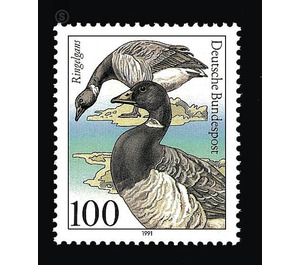Animal welfare - Threatened seabirds - Germany / Federal Republic of Germany 1991 - 100 Pfennig
Theme: Animals
| Country | Germany / Federal Republic of Germany |
| Issue Date | 1991 |
| Face Value | 100.00 |
| Color | multi-colored |
| Perforation | K 13 3/4: 14 |
| Printing Type | 4-color offset printing |
| Stamp Type | Postage stamp |
| Item Type | Stamp |
| Chronological Issue Number | 1414 |
| Chronological Chapter | GER-BRD |
| SID | 654375 |
| In 50 Wishlists | |
From the far north - the nearest breeding sites are on Spitsbergen, Franz Josef Land, in eastern Siberia and northeast Greenland - comes the relatively small striped goose (total length 560 to 590 mm, for comparison: Greylag goose 700 to 820 mm) in each winter season to Europe. The whitish side spots on the black neck make the style unmistakable. The winter quarters are located in the western Baltic Sea (eg near the island of Poel in the Wismar Bay), in the North Sea region, on the coasts of Germany, England, the Netherlands, France etc. They appear here from September, in October and also still in November and stay until March / April, move back at the beginning of May at the latest. On peninsulas and islands, usually near the coast or at river mouths, the ringed geese are found in their homelands to breed colonies, often to several thousand. In the expanses of the tundra, they erect their bottom nests on slightly elevated, surveyed places, consisting of a hollow lined with lichen, mosses and abundant down, which they tear themselves out. The female hatches alone the (2) 3 to 5 (8) eggs. The male only acts as a guardian, destroying enemies and always stays in the immediate vicinity of the nest. The breeding season lasts 22 to 24 days. The Gössel are nest-breeders, are led by both parents, which is often joined by several families. These families and extended families will stay together until the next breeding season. Ringed geese feed on a variety of plants that grow in the tundra, as well as seaweed and kelp, as well as other aquatic plants; They also occasionally pick up mussels and other small animals.


